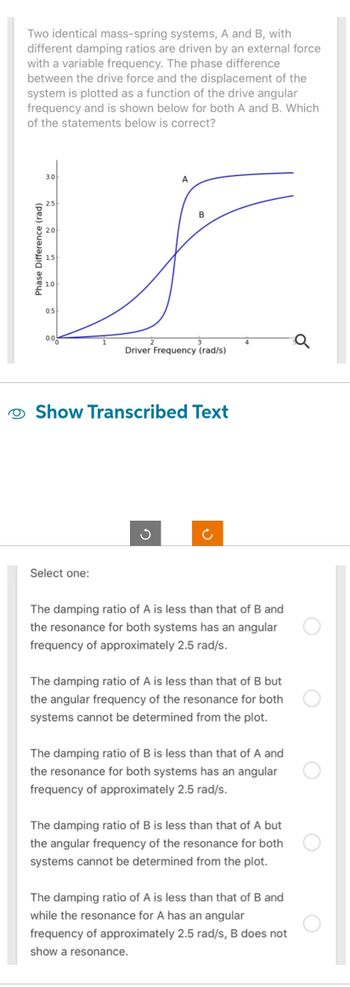
University Physics Volume 1
18th Edition
ISBN: 9781938168277
Author: William Moebs, Samuel J. Ling, Jeff Sanny
Publisher: OpenStax - Rice University
expand_more
expand_more
format_list_bulleted
Question
No chatgpt pls will upvote

Transcribed Image Text:Two identical mass-spring systems, A and B, with
different damping ratios are driven by an external force
with a variable frequency. The phase difference
between the drive force and the displacement of the
system is plotted as a function of the drive angular
frequency and is shown below for both A and B. Which
of the statements below is correct?
3.0
Phase Difference (rad)
1
0.5
A
B
0.0
4
Q
0
Driver Frequency (rad/s)
Show Transcribed Text
D
Select one:
The damping ratio of A is less than that of B and
the resonance for both systems has an angular
frequency of approximately 2.5 rad/s.
The damping ratio of A is less than that of B but
the angular frequency of the resonance for both
systems cannot be determined from the plot.
The damping ratio of B is less than that of A and
the resonance for both systems has an angular
frequency of approximately 2.5 rad/s.
The damping ratio of B is less than that of A but
the angular frequency of the resonance for both
systems cannot be determined from the plot.
The damping ratio of A is less than that of B and
while the resonance for A has an angular
frequency of approximately 2.5 rad/s, B does not
show a resonance.

Expert Solution
This question has been solved!
Explore an expertly crafted, step-by-step solution for a thorough understanding of key concepts.
Step by stepSolved in 2 steps with 1 images

Knowledge Booster
Similar questions
- Some people modify cars to be much closer to the ground than when manufactured. Should they install stiffer springs? Explain your answer.arrow_forwardConsider the damped oscillator illustrated in Figure 12.16a. The mass of the object is 375 g, the spring constant is 100 N/m, and b = 0.100 N s/m. (a) Over what time interval does the amplitude drop to half its initial value? (b) What If? Over what time interval does the mechanical energy drop to half its initial value? (c) Show that, in general, the fractional rate at which the amplitude decreases in a damped harmonic oscillator is one-half the fractional rate at which the mechanical energy decreases.arrow_forwardHow would a car bounce after a bump under each of these conditions? (a) overdamping (b) underdamping (c) critical dampingarrow_forward
- Check Your Understanding Identify an object that undergoes uniform circular motion. Describe how you could trace the SHM of this object.arrow_forwardFind the frequency of a tuning fork that takes 2.50103 s to complete one oscillation.arrow_forwardReciprocating motion uses the rotation of a motor to produce linear motion up and down or back and forth. This is how a reciprocating saw operates, as shown below. If the motor rotates at 60 Hz and has a radius of 3.0 cm,estimate the maximum speed of the saw blade as it moves up and down. This design is known as a scotch yoke.arrow_forward
- A 50.0-g object connected to a spring with a force constant of 35.0 N/m oscillates with an amplitude of 4.00 cm on a frictionless, horizontal surface. Find (a) the total energy of the system and (b) the speed of the object when its position is 1.00 cm. Find (c) the kinetic energy and (d) the potential energy when its position is 3.00 cm.arrow_forwardThe amplitude of a lightly damped oscillator decreases by 3.0% during each cycle. What percentage of the mechanical energy of the oscillator is lost in each cycle?arrow_forwardHow long does it take a child on a swing to complete one swing if her center of gravity is 4.00 m below the pivot?arrow_forward
- Is it possible to have damped oscillations when a system is at resonance? Explain.arrow_forwardWhat conditions must be met to produce SHM?arrow_forwardRefer to the problem of the two coupled oscillators discussed in Section 12.2. Show that the total energy of the system is constant. (Calculate the kinetic energy of each of the particles and the potential energy stored in each of the three springs, and sum the results.) Notice that the kinetic and potential energy terms that have 12 as a coefficient depend on C1 and 2 but not on C2 or 2. Why is such a result to be expected?arrow_forward
arrow_back_ios
SEE MORE QUESTIONS
arrow_forward_ios
Recommended textbooks for you
 University Physics Volume 1PhysicsISBN:9781938168277Author:William Moebs, Samuel J. Ling, Jeff SannyPublisher:OpenStax - Rice University
University Physics Volume 1PhysicsISBN:9781938168277Author:William Moebs, Samuel J. Ling, Jeff SannyPublisher:OpenStax - Rice University Principles of Physics: A Calculus-Based TextPhysicsISBN:9781133104261Author:Raymond A. Serway, John W. JewettPublisher:Cengage Learning
Principles of Physics: A Calculus-Based TextPhysicsISBN:9781133104261Author:Raymond A. Serway, John W. JewettPublisher:Cengage Learning Classical Dynamics of Particles and SystemsPhysicsISBN:9780534408961Author:Stephen T. Thornton, Jerry B. MarionPublisher:Cengage Learning
Classical Dynamics of Particles and SystemsPhysicsISBN:9780534408961Author:Stephen T. Thornton, Jerry B. MarionPublisher:Cengage Learning College PhysicsPhysicsISBN:9781938168000Author:Paul Peter Urone, Roger HinrichsPublisher:OpenStax College
College PhysicsPhysicsISBN:9781938168000Author:Paul Peter Urone, Roger HinrichsPublisher:OpenStax College Physics for Scientists and Engineers, Technology ...PhysicsISBN:9781305116399Author:Raymond A. Serway, John W. JewettPublisher:Cengage Learning
Physics for Scientists and Engineers, Technology ...PhysicsISBN:9781305116399Author:Raymond A. Serway, John W. JewettPublisher:Cengage Learning Physics for Scientists and Engineers: Foundations...PhysicsISBN:9781133939146Author:Katz, Debora M.Publisher:Cengage Learning
Physics for Scientists and Engineers: Foundations...PhysicsISBN:9781133939146Author:Katz, Debora M.Publisher:Cengage Learning

University Physics Volume 1
Physics
ISBN:9781938168277
Author:William Moebs, Samuel J. Ling, Jeff Sanny
Publisher:OpenStax - Rice University

Principles of Physics: A Calculus-Based Text
Physics
ISBN:9781133104261
Author:Raymond A. Serway, John W. Jewett
Publisher:Cengage Learning

Classical Dynamics of Particles and Systems
Physics
ISBN:9780534408961
Author:Stephen T. Thornton, Jerry B. Marion
Publisher:Cengage Learning

College Physics
Physics
ISBN:9781938168000
Author:Paul Peter Urone, Roger Hinrichs
Publisher:OpenStax College

Physics for Scientists and Engineers, Technology ...
Physics
ISBN:9781305116399
Author:Raymond A. Serway, John W. Jewett
Publisher:Cengage Learning

Physics for Scientists and Engineers: Foundations...
Physics
ISBN:9781133939146
Author:Katz, Debora M.
Publisher:Cengage Learning